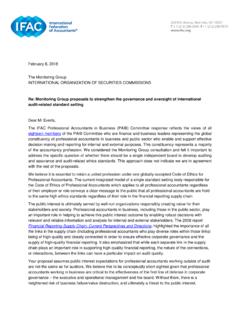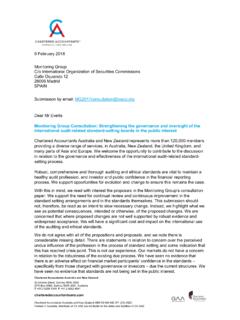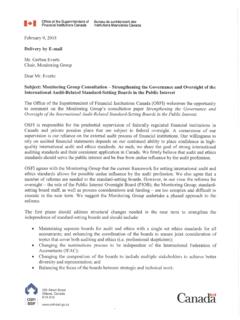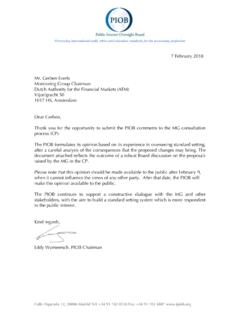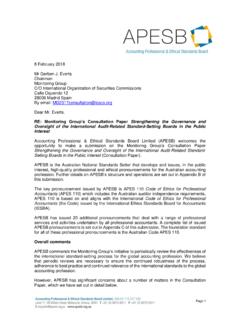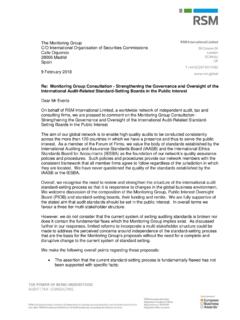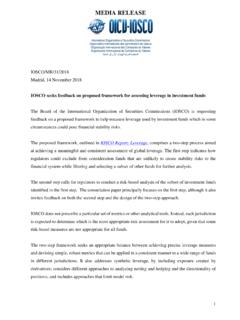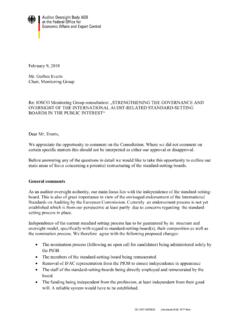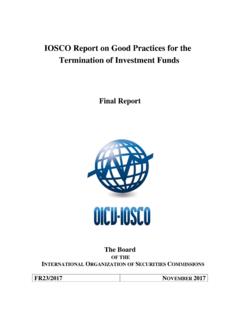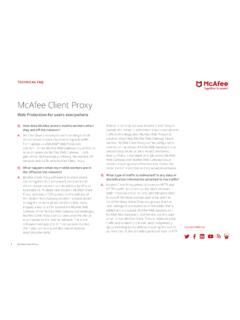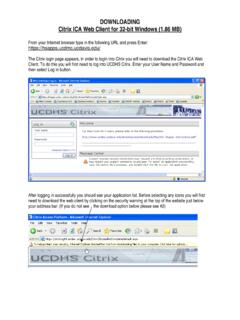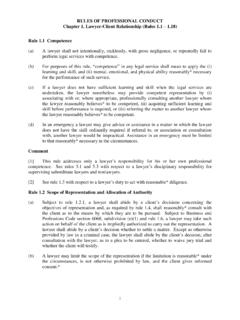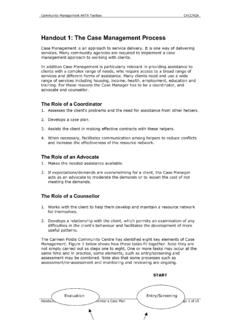Transcription of Committee on Infrastructures Organization of Securities A ...
1 Committee on Payments and Market Infrastructures Board of the International Organization of Securities Commissions A discussion paper on client clearing: access and portability November 2021 Deadline For Comments Extended Until 7 February This publication is available on the BIS website ( ) and the IOSCO website ( ). Bank for International Settlements and International Organization of Securities Commissions 2021. All rights reserved. Brief excerpts may be reproduced or translated provided the source is stated. ISBN 978-92-9259-495-4 (online) A discussion paper on client clearing: access and portability 1 Contents Executive summary .. 2 1. Introduction .. 3 2. Access .. 4 Direct and sponsored access models in brief .. 4 Challenges related to direct and sponsored access models .. 5 Common feature: shifting responsibility for default or clearing fund contribution.
2 5 New models, new direct clearing participants, new incentives .. 5 The issue of a potential sponsor default .. 6 Recent uptake/activity of models .. 7 Impact on access .. 8 3. Porting .. 8 Potentially effective porting practices .. 9 Alternate CCSPs for clients of defaulted CCSPs .. 9 Account structures that facilitate clients maintaining fully margined positions .. 10 Communication, coordination and harmonisation .. 12 Communication and coordination .. 12 Harmonisation .. 12 Notable issues to consider when developing a porting protocol .. 13 Regulatory impediments to successful porting .. 13 Insolvency framework .. 13 Collateral transfer .. 14 Testing .. 14 Transparency for clients .. 14 Suggested next steps for consideration by CCPs, CCSPs and clients .. 15 4. Feedback on the discussion 16 Access (Section 2).
3 16 Porting (Section 3) .. 17 Annex A: Members of the PSG and the Client Clearing Subgroup .. 19 2 A discussion paper on client clearing: access and portability Executive summary Firms who are not direct participants of a central counterparty (CCP) must rely on having their trades cleared by an intermediary, a client clearing service provider (CCSP), who is a direct participant of the CCP. Firms who are not able to become, or choose not to become, a direct participant of a CCP are generally known as clients , and the term client clearing encompasses the activities and the services that enable clients access to This paper is a discussion paper on issues concerning client clearing. In particular, this paper considers issues concerning access to CCPs and effective porting practices. The paper does not intend to provide guidance on the Principles for financial market Infrastructures (PFMI)2 but only to increase the common understanding on new access models and effective porting practices and identify potential issues for possible follow-up work from the industry.
4 The analysis elaborates on information collected through: (i) an industry workshop in July 2019; (ii) a survey addressed to CCPs, CCSPs and clients in late 2019; and (iii) targeted interviews in the autumn of 2020. The purpose of this paper is to: (1) develop knowledge and understanding regarding new access models by which entities that historically have participated indirectly as clients could directly access CCP services; (2) develop knowledge and understanding of current porting processes in place at CCPs; (3) examine and analyse possible solutions to facilitate access and portability arrangements; (4) consider in particular the potential benefits, risks and challenges that these new possible solutions may bring with respect to access (Principle 18 of the PFMI), tiering (Principle 19) and portability (Principle 14); and (5) elicit comments and feedback from a broad range of interested stakeholders.
5 Section 1 briefly explains the reasons why the work was conducted and the objectives of the work. Section 2 describes direct and sponsored access models that allow entities that have historically participated indirectly as clients to directly access CCP services. These new models introduce new challenges, incentives and risk distribution among different kind of participants. They also introduce new risks (eg the risks related to the sponsor default), with the availability and use of these types of models varying significantly in different segments of cleared markets. These models, for instance, are not used widely for the derivatives markets. Section 3 outlines potentially effective porting practices, focusing in particular on alternative CCSP arrangements and game plans. The implications of legal frameworks and account structures, which vary in availability by jurisdiction, are also considered.
6 Overall, two effective practices consistently appeared to support successful porting in the event of a default: (i) pre-emptively identifying potential alternate CCSPs (by either the client or the CCP s analysis); and (ii) use of account structures that facilitate fully margined client positions. It then proposes possible effective practices concerning three key elements of a successful CCP porting framework communication, coordination, and harmonisation. In particular, it sets forth issues for CCPs consideration when developing a porting protocol and identifies a series of suggested next steps for the industry with regard to porting practices. Comments and feedback are welcome by 24 January 2022. Section 4 sets forth a series of questions for feedback. 1 Principle 14 of the Principles for financial market Infrastructures (PFMI) refers to the clearing members of a CCP as participants , while clients of the clearing members are referred to as participants customers in Principle 14 and indirect participants in Principle 19.
7 To avoid confusion in this discussion paper and reflect changing relationships, the term CCSP is generally used rather than participant and the term client is used rather than participants customer. 2 CPSS-IOSCO (2012). A discussion paper on client clearing: access and portability 3 1. Introduction In 2009, the G20 Leaders made a commitment to ensure that all standardised over-the-counter (OTC) derivatives contracts are cleared through CCPs. Increased use of central clearing generally, and with a particular focus on derivatives since the 2009 G20 commitment, is intended to enhance financial stability by simplifying the network of counterparty exposures between financial institutions and reducing the aggregate size of these exposures through multilateral netting by a CCP. In light of the introduction of clearing mandates in some jurisdictions, CCPs have become increasingly critical components in the financial system.
8 In 2018, the Derivatives Assessment Team (the DAT Report)3 confirmed that the provision of client clearing services was concentrated in a relatively small number of bank-affiliated clearing firms. clients are not typically direct clearing participants but rather require access to clearing through clearing participants. As a result, access to client clearing is a critical issue for the success of the G20 reforms, especially in jurisdictions where the clearing obligation also applies to clients . Principle 19 of the PFMI states that financial market Infrastructures (FMIs), including CCPs, should identify, monitor, and manage the material risks to the FMI arising from tiered participation arrangements . Moreover, Principle 14 of the PFMI states: a CCP should have rules and procedures that enable the segregation and portability of a participant s customers and the collateral provided to the CCP with respect to these positions.
9 Against this background, CPMI and IOSCO decided to analyse whether and to what extent concentration in client clearing creates issues of concern specifically in relation to client access. In particular, the CPMI-IOSCO Steering Group mandated the Policy Steering Group (PSG) to: (1) develop knowledge and understanding regarding new access models by which entities (that historically have participated indirectly as clients ) could directly access CCP services; (2) develop knowledge and understanding of current porting processes in place at CCPs; (3) examine and analyse possible solutions to facilitate access and portability arrangements; and (4) consider the potential benefits, risks and challenges that new access models and potential solutions may bring with respect to The PSG gathered information through an industry workshop in July 2019 and a survey addressed to CCPs, CCSPs and clients in late 2019 as well as follow-up work through targeted interviews in the autumn of 2020.
10 Section 3 provides an overview of direct and sponsored access models based on the results of the survey and targeted interviews described above; considers challenges related to direct and sponsored access models; recent uptake and activity; and the impact of direct and sponsored access models on access. Section 4 describes an overview of potentially effective porting practices, drawing attention to communication, coordination and harmonisation as fundamental principles for successful porting. It also describes notable obstacles to address when developing a porting protocol and suggests next steps for industry consideration. There is significant heterogeneity in the business models of CCPs and CCSPs, as well as in regulations across jurisdictions, so not all of the suggestions are equally applicable. 3 See FSB, Incentives to centrally clear over-the-counter (OTC) derivatives, November 2018, 4 Principle 18 of the PFMI provides that FMIs, including CCPs should have objective, risk-based, and publicly disclosed criteria for participation, which permit fair and open access.

